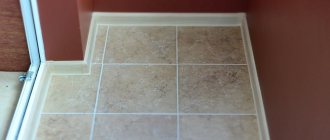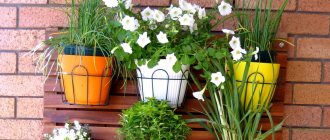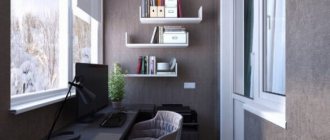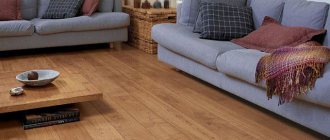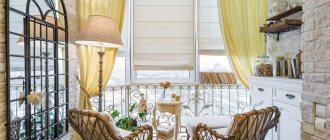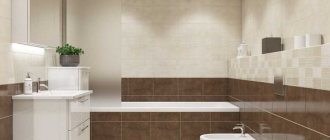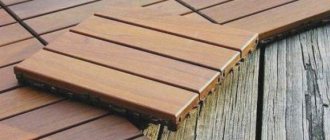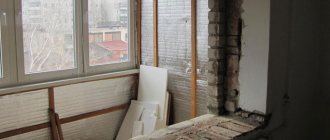When arranging a balcony, finishing materials, including flooring, play an important role. The floor must fully correspond to the type of room, otherwise there can be no question of comfort. The range of flooring materials is unusually wide, and making a choice is not always easy, especially for someone inexperienced in construction matters. That is why, before starting repairs, you need to choose the right type of coating.
How to lay the floor on the balcony
Requirements for floors on balconies
Balconies can be open or glazed, which means that the requirements for flooring will differ significantly. Much depends on how the balcony is used: as a relaxation area, a study, a greenhouse or a warehouse for unnecessary things. In each specific case, you need to take into account the operating conditions so as not to make a mistake when choosing materials.
Open balconies
Open balconies
The floor on an open balcony is constantly exposed to temperature changes, exposure to sunlight, rain and snow. Therefore, the floor covering must have high strength, frost resistance, not absorb moisture, be easy to clean from dirt, be non-flammable and non-slippery. Such requirements greatly limit the choice of materials, but it is still quite wide: ceramic tiles and porcelain stoneware, rubber tiles, decking, special rubber paints, PVC panels. Linoleum is also suitable for balcony floors, but not ordinary, but frost-resistant, which appeared on the construction markets not so long ago.
Closed balconies
Closed balconies
On glazed balconies, the floor is protected from rain and snow, fades less in the sun, and is less dirty. The most important factor here is the presence or absence of heating. A heated, insulated balcony is practically no different from a living room, and any covering can be laid there. If the balcony is not heated, but is insulated, the floor covering must withstand temperature fluctuations in winter and summer. If the balcony is simply glazed, without insulation of the walls and floor, the floor covering must be frost-resistant.
Balcony operating conditions
Relaxation corner with soft rug
When planning to create a relaxation area on the balcony, choose a material that is pleasant to the touch, environmentally friendly, but at the same time resistant to abrasion and ultraviolet rays. If you do not plan to have a warm floor underneath the covering, you should not lay tiles or make a self-leveling floor - such a surface will be very cold. It is better to use laminate, any wooden coverings, or linoleum on a thick backing.
Linoleum on the balcony
Any practical covering is suitable for a work office, not necessarily expensive or overly decorative. The material should be easy to clean from dust, not emit harmful fumes, and not be pressed under the legs of a table with a computer or other furniture.
Office on the balcony. Covering: ceramic tiles
If you plan to arrange a mini-greenhouse or winter garden on the balcony, the floor must be waterproof. When watering and replanting plants, water often spills on the floor, soil, and flower fertilizers get in. It is very easy to slip and fall on a dirty wet surface, which means you also need to choose an anti-slip coating.
Balcony - greenhouse. On the floor there is fine gravel and wooden boards
In the case when the balcony is used as a warehouse, it is best to cover the floor with an easy-to-care material that is not afraid of temperature changes and mechanical stress. It can be ordinary tiles or the same linoleum. It is not practical to lay expensive decorative materials on such a balcony. So, knowing the list of requirements for floor coverings, you should study in more detail the properties of the most popular materials.
Do-it-yourself dry floor screed in an apartment: technology for laying gypsum fiber boards
The surface of the dry screed is formed from gypsum fiber sheets (GVL), which are a compressed mixture of gypsum with loose cellulose fibers. Such sheets are stronger than drywall. To connect them together, a seam edge is required. Where the edge overlaps the adjacent sheet, the joint must be glued with special glue and secured with screws. According to the technology for installing dry floor screed, it is recommended to start laying sheets from the front door. Installation of the first sheets may require space on top of the embankment. In order for it to remain level, it is necessary to place a sheet of gypsum fiber board on top measuring no less than 50 x 50 cm, so that you can safely stand on it. Next, each sheet must be laid on the embankment one after another, turning all the joints with screws at a frequency of every 5 cm.
After all the sheets are laid on the floor and firmly fastened, you can proceed to trimming the protruding part of the insulator strip along the entire perimeter of the floor. To do this, it is recommended to use a regular stationery knife. Depending on what kind of top floor covering will be used, a number of other necessary measures must be taken.
When using a dry screed in a bathroom or kitchen, it is necessary to install another layer of waterproofing: film or bitumen coating. If tiles are laid in the corridor, the dry screed technology does not require any additional actions. In this case, you should simply lay the tiles using adhesives on top of the screed.
If not ceramic tiles are used, but any other coating (laminate, linoleum, self-leveling floors, etc.), then the joints between the gypsum plasterboard sheets and all screw heads must be puttied.
To install a dry floor screed with your own hands, one day is enough. The result will be a finished, flat surface for further finishing work. But it is still recommended to let the dry screed rest for at least a day.
Next, you can familiarize yourself with the features of semi-dry floor screed technology and watch the corresponding video.
Tile
The advantages of tiles are obvious:
- highly decorative;
- long service life;
- strength;
- frost resistance;
- resistance to chemicals;
- environmental friendliness;
- absolutely non-flammable.
Tiles for the balcony
It is easy to care for; installation, although it requires some skill, is not particularly difficult. All this makes tiles an almost ideal floor covering for a balcony. To reduce the load on the floors, lightweight tiles are produced, and for open balconies there are a lot of options with a rough anti-slip surface.
Balcony floor tiles
Flaws:
- tile floors are cold to the touch, so on closed balconies it is recommended to lay them on top of underfloor heating systems;
- The surface of the tile has very low sound insulation, and when walking there are booming sounds from steps.
The range of floor tiles is unusually wide; models differ in manufacturing method, decorativeness, size, presence or absence of glaze.
Ceramic or tile
Tile
This type of tile is considered the most common. It consists of a mixture of sand, clay and modifying additives, pressed and fired at high temperature. After cooling, a decorative glaze coating is applied to the surface of the tiles, which gives the tiles such an aesthetic appeal.
Porcelain tiles
Laying porcelain tiles on the balcony
When making porcelain stoneware, the working mixture is fired at higher temperatures than tiles, so the finished material has an external resemblance to natural stone and has the same technical characteristics in terms of frost resistance, strength, and durability. Porcelain stoneware is produced both in pure form and with a glazed coating; it looks very decorative, but is a rather expensive material.
Clinker tiles
Clinker tiles
This type of tile is durable, very wear-resistant, and is not afraid of moisture and freezing temperatures. This coating is ideal for an open balcony; moreover, the cost of clinker tiles is lower than porcelain tiles.
There are several other types of tiles, among which Cotto and quartz vinyl tiles are worthy of attention; each variety has its own characteristics. To make this coating look most impressive, follow several important rules when choosing.
Clinker tiles Feldhaus klinker, Stroeher
- Large tiles visually make the balcony smaller, so the smaller the area, the smaller the tiles should be. For balconies of standard size, experts recommend choosing 40x40 cm tiles.
- Dark colors also visually make a room smaller, while bright and light shades make it feel more spacious. This is especially important for balconies located on the north side, where there is too little light.
- For a glazed and insulated balcony, you should purchase tiles with wear resistance class PEI 3. The higher the rating, the more massive and heavier the material.
- Tiles should be purchased at one time, and with a small margin - about 5-7%. The tiles from the second batch may differ slightly in color, and if you suddenly have to buy additional material, the coating will be uneven.
Linoleum
Linoleum
Advantages of linoleum:
- great variety and decorativeness;
- ease of installation;
- ease of care;
- relatively low price;
- water resistance.
Modern types of linoleum are characterized by increased resistance to abrasion, fade less in the sun, and are more resistant to aggressive substances.
Linoleum is an inexpensive and practical coating
Flaws:
- short service life;
- some species emit harmful fumes;
- when the temperature drops, linoleum loses flexibility and may break;
- deformed under the influence of mechanical loads.
Some types of linoleum can even be laid on open balconies
Traditional types of linoleum are not intended for installation in unheated rooms, especially on open balconies. But thanks to the development of technology, frost-resistant linoleum has appeared, as well as coatings with an anti-slip surface. Add to this the aesthetic appeal of the material - and you get an excellent coating for a balcony, regardless of its type and the presence of heating. Of course, the cost of such linoleum is higher than usual, but not by much. Linoleum can be baseless, as well as on a jute and foam base.
| Linoleum base | Description |
| Baseless linoleum | This material is characterized by a homogeneous structure throughout the entire thickness of the layer. This means that during long-term use the coating will not fade and the pattern will not be erased. Some models have a rough surface, so the risk of slipping is minimal. The thickness of such linoleum is 3 mm, and it must be laid on a carefully prepared, even base. |
| Foam based | This type of linoleum is considered the most durable and easy to use. Due to its immunity to moisture, it can be used in absolutely any room. On a closed, insulated balcony, such a coating will easily last up to 10 years with proper care. |
| Jute based | The thick jute base retains heat well, so this linoleum is quite suitable for a glazed balcony. It can be laid directly on a screed, self-leveling floor, as well as raised floors made of chipboard or plywood. This type of coating cannot be used on open balconies. |
Preparatory work
Once the insulation has been selected, proper preparation for its installation must be carried out. To begin with, it is worth assessing the general condition of the floor. If it is satisfactory, that is, the surface is without defects, relatively smooth, and does not crumble, you can proceed to the next stage.
Instagram balcon_dizain
The base can be tiled. Dismantling will be unnecessary, provided that it is well preserved. The insulation fits well on the tiled surface. No special preparation is required.
If there are significant defects in the base in the form of cracks, chips or potholes, it is advisable to eliminate them
It does not matter that the surface will subsequently be covered with an insulator. The flaws will become reservoirs of sorts where moisture will begin to accumulate.
Subsequently, colonies of microorganisms can settle here, and pockets of erosion will appear. Therefore, all defects are carefully repaired.
The protrusions are chipped off, the cracks are carefully repaired. That is, they expand at an angle so that the repair compound can fill them as tightly as possible. Then everything is well cleaned of dust and primed. After the primer has dried, the defective areas are filled with sealant, putty, etc. After the composition has completely dried, the “patches” are cleaned so that they do not protrude above the floor level. It is most likely not worth installing a screed. It will significantly make the structure heavier.
The next important stage is waterproofing. Balcony slab is porous. This means that if insulated from the inside, it will still absorb moisture coming from outside. Water through the capillaries will quickly reach the heat insulator and begin to destroy it.
Instagram konstantin_remont_kvartirperm
Therefore, it is necessary to lay a layer of waterproofing coating. You can choose any option. The easiest way to work is with mastic, which is applied using a roller or brush. But you can also lay rolled fabric.
Garden parquet
Garden parquet
Garden parquet, decking, decking - all these are names for very practical and decorative coverings made of wood-polymer composites or very hard wood.
Advantages:
- low weight of the coating;
- water resistance;
- weather resistance;
- aesthetics;
- ease of installation.
Garden parquet (decking)
The coating is produced in the form of compact modules that can be laid on logs or mounted on a flat surface, connecting like a construction set. The only disadvantage of decking is its cost, since not everyone can afford it. Garden parquet is suitable for floors on both open and glazed balconies, goes well with any type of decoration and gives the room a touch of originality.
PVC tiles
PVC tiles
Vinyl tiles are an excellent solution for an enclosed balcony. Thanks to the variety of colors, you can independently create an original pattern on the floor that will decorate your balcony.
Advantages:
- ease of installation;
- water resistance;
- non-flammability;
- resistance to aggressive substances;
- highly decorative;
- small thickness;
- durability;
- environmental friendliness;
- practicality.
PVC tiles - a variety of shades and textures
In addition, the top layer has antistatic and anti-slip properties. The material is easy to cut, and therefore, when laying, you can even make an applique on the floor by choosing the appropriate pattern. There are plain models, wood, marble, and other natural materials. No glue or mastic is required to attach the covering to the base: the bottom layer of the tile is self-adhesive.
The material is laid on both a wooden and concrete base, the main thing is that it is as level as possible. If you have a wooden floor on your balcony, you can freshen up the interior by laying tiles on top of the boards. Such repairs will take a minimum of time, and the result will be very impressive. If laying is done on a cement screed, first grind and clean the surface from dust, then prime it. When installed on a dusty or uneven substrate, the quality of the coating will be very poor.
| Name | Characteristics | approximate cost |
| Bamboo parquet | Durable, wear-resistant, environmentally friendly material | from 1950 rub./m2 |
| Marmoleum | Non-flammable waterproof material with high decorative properties | from 980 rub./m2 |
| Liquid tile | Unique coating with 3D effect, impact-resistant and UV-resistant | from 14990 RUR/m2 |
| Leather tiles | Elite coating with high decorative properties, strong and durable | 2500-4000 rub./m2 |
| Glass floor | High-strength non-flammable coating, resistant to abrasion, mechanical stress, and chemicals | from 4000 rub./m2 |
Final work
When all the rough, dirty work has been completed, the waterproofing and insulation have been laid, the cherished moment comes: installation of the finishing coating. Upon completion of laying the floor, there is a feeling that several details are missing for the integrity of the picture:
- baseboards;
- rugs;
- paints on a wooden (concrete) floor.
This additional amount of work may not be performed, but without it the coating will not be complete.
If the floor is wooden, then lovers of everything natural, to emphasize the structure of the wood, presentability and additional protection, use alkyd varnish for exterior woodwork. It would be good if it has antiseptic properties and resistance to ultraviolet rays and moisture. The varnish can be either glossy or matte, with the latter looking more impressive.
Painted floor
It is enough to perform a simple procedure for painting a wooden or concrete surface using alkyd, oil-based or polyurethane paints. This procedure is as simple as possible, the main thing is the right paint. It is recommended to remove the old layer first, because... On old paint, new paint will not last long: peeling and bumpiness may occur. This will ruin the entire appearance of the finish and you will have to resort to drastic measures.
In search of interesting color solutions, you can paint both wooden and concrete floors with special paints: polyurethane, oil or acrylic paints for exterior use. You can use carpet as an additional insulating coating on top of tile floors and wood coverings.
A special anti-slip mat, or even several if the balcony area allows, acts as a decorative element and prevents falls on slippery tiles. They can be made in different sizes with different patterns, abstractions, 3D effect, transparent and even glowing in the dark. For cold floors, heated mats powered by batteries would be an interesting functional solution. Textile floor products will add coziness and homely warmth to a loggia or balcony.
Laminate
Laminate
Laminate can only be used on closed balconies with good waterproofing. Some types of laminate are even suitable for laying on heated floors. This coating is durable, has an aesthetic appearance, and if the panel is damaged it is easy to replace. The main condition for installing laminate flooring is a flat, smooth surface, which means that the base must be properly prepared.
Laminate on the balcony
Advantages of laminate:
- withstands long-term loads;
- does not fade in the sun;
- tolerates temperature changes well;
- fireproof;
- Resistant to chemicals.
The range of laminate flooring is very wide, the colors and textures are incredibly varied. You can easily choose a covering to match the interior of your balcony.
Laminate classification
Which laminate to choose
Selection of materials
Before you start building a balcony or loggia, you need to select a material. Before you start building a balcony or loggia, you need to select a material.
This is a very important job; not only the aesthetics, but also the practicality of the additional space will depend on it. A glazed balcony accepts wood or wood derivatives well: laminate, tongue and groove boards and even parquet. But in this case, the flooring includes high-quality waterproofing materials to preserve all the beneficial properties of wood. It is useful to cover the open space of the balcony/loggia with tiles and linoleum. The products are resistant to the external environment and installation will not require renewal after the first rains. Owners of Khrushchev apartments can be advised to have heated floors; such finishing will not only significantly expand the usable area, but also make the space a full-fledged living space. It’s even better to remove the floor so that the Khrushchev-era balcony “merges” into the rooms and becomes their continuation.
Other types of coatings
Very often, floors on closed balconies are made of wood. Both ordinary boards and wooden lining give the balcony a very cozy, lived-in look and saturate the air with the smell of wood. Of course, natural wood is expensive and requires high-quality protection from moisture. In addition, the wooden surface must be periodically treated to restore the structure. But at the same time, the tree is not afraid of freezing, it is durable and does not contain harmful substances. This coating is suitable for closed balconies, both insulated and not insulated, as well as for heated balconies, but only if it is not a heated floor system. When installed on a heated floor, the wood becomes deformed under the influence of heat, dries out, and begins to creak.
Wooden floors
Another good option for a closed, insulated balcony is carpet. This coating is soft and cozy, pleasant to the touch. If the balcony is used as a relaxation area, carpet will be an ideal option for arranging the floor.
Carpet
If the balcony is open and you have no desire to tinker with tiles or porcelain stoneware, use rubber paint for the coating. It does not fade, adheres firmly to the base, does not wear off for a very long time, and is not afraid of water, frost, or summer heat. To apply paint use brushes, rollers or a spray gun. The most important thing is to properly prepare the base. To do this, the concrete screed is leveled as much as possible, ground, and treated with a primer. Please note that even small errors under a layer of paint are clearly visible, and this reduces the attractiveness of the floor.
The floor is covered with rubber paint
Rubber paint was named so because the film formed on the surface of the paint is very flexible; if desired, it can be rolled into a small tube
There are many other coverings that can be used to cover a balcony, and it’s quite difficult to describe everything. The listed materials are the most popular and affordable; you can find them in any construction supermarket. In addition, each of the above-described coatings is easy to install independently, without resorting to the services of craftsmen.
Comparison table of floor coverings
| Type of coverage | Service life, years | Decorativeness | Ease of maintenance | Resistance to mechanical loads | Environmental friendliness | Maintainability |
| Parquet | 15-20 | average | average | not high | high | low |
| Linoleum | 3-7 | low | easily | not high | low | Can not be repaired |
| Tile | 5-15 | average | average | average | high | average |
| Carpet | 1-5 | low | hard | not high | low | Can not be repaired |
| Laminate | 3-7 | low | average | not high | low | Can not be repaired |
| Polymer | 10-30 | high | easily | high | high | high |
Video - How to lay the floor on the balcony
How to install a heating structure
The process of installing a water floor is more complicated than others, since it will require checking the pipes before laying them and covering them with screed. The other options are simpler in this regard, but they heat up less than a water floor.
Installation of a water system
Purely technically, installation is carried out according to the same scheme as for electric floors. Installation is carried out on a concrete screed or between wooden joists. Concrete is considered stronger, plus it serves as an excellent heat conductor and retains it for a long time.
Water heated floor
The floor on which work will be carried out must be perfectly level.
It is important to take this nuance into account, since during construction, external structures are made at a slight slope so that water does not linger on the roof, but flows calmly down. A water-based structure requires an additional layer of waterproofing
The material that provides protection from water should extend beyond the floor and be slightly higher than the final coating.
For the flooring itself, a flexible metal-plastic pipe is used. It is fixed to the thermal insulation with small clamps. A rubber corrugation is installed at the place where the clamp covers the pipe. This protects the folds from sudden refraction.
The pipe is laid in coils or snails. The distance between the pipes is 10-15 cm. They should be no closer than 5 cm to the wall. Intersections are not allowed.
A polyethylene tape is laid along the perimeter of the wall so that there is a damping gap when the screed shrinks. The screed is made from a self-leveling material or from a mixture of cement and sand using beacons. Afterwards, wait for the composition to dry completely (7 days) and lay the final cladding (after 1 month).
Dry installation is done on wooden logs. It is not necessary to level the surface for them; just insert the wedges. Logs are placed every 30 cm. The height of the structure is about 7 cm (the width of the insulation and pipe is taken into account).
Polyethylene is placed on the thermal insulation, and lathing is placed on it. The insulation is laid between the joists, securing the free space with polyurethane foam. In order for the pipe to pass through all the joists, grooves must be made at the joints. A layer of plywood is laid before the facing covering.
Cable system installation
The method of laying the cable is the same as for the water pipe. For convenience and ease of installation, you can use special electric mats. This is a thin cable that is supported by fiberglass film. They are easier to attach to thermal insulation.
Connection diagram for cable heated floor
A layer of metal reinforcing mesh is laid in front of the mats. There is no need to secure the mats. The tile covering can be laid directly on them using special glue.
The cable is installed similarly to a water pipe. At the bend points it is intercepted with clamps, which are fixed into thermal protection. A screed is poured on top and tiles are laid.
Installation of infrared system
The simplest option takes several hours. Before applying the film, the thermal protection is covered with an insulating layer of foamed polymer fabric. It is covered with foil. The joints are sealed with special tape.
Sensors and contacts must be flush with the floor; holes are made under them in insulation. The film is laid on top of the isolon. The contacts are pressed off and insulated.
A protective layer of polyethylene is laid on top. Next, you can lay any floor covering. Any material can be used for this type of heating deck. No screed is needed after applying the film.
Installation of infrared film floor
Such a heated floor system can heat not only the facing covering, but also the walls next to it, which is a particular advantage for lovers of house plants. Heating will help them survive the winter on the balcony.
It is difficult to dismantle decks filled with concrete screed; the help of specialists will be required. Wooden logs are easily removed, as is the film system.
Installing a system on a balcony can be a very troublesome task, but making a heated floor on a balcony with your own hands is possible. After installing the final screed, the walls of the room are finished. Flooring renovations are being completed
It is important to choose the right heating for the type of room. Prepare a flat surface, hydro and thermal insulation
Pipes or cables must be fixed; there should be no air left in the space between the thermal insulation and the screed.
A heated floor system will be useful for those who dry clothes on the balcony or want to create a quiet corner for practicing hobbies. The glass in such a room will not freeze; warm air from the flooring rises and prevents it from becoming covered with frost.
Opening the windows on the loggia where the structure is installed is completely safe; the temperature difference will not affect its safety in any way.
